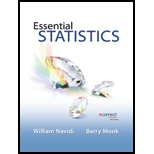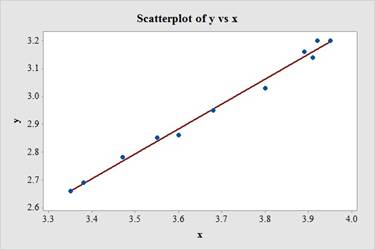
a.
Find the least-squares regression line to predict the 15-year rates from 30-year rates.
a.
Answer to Problem 26E
The least-squares regression line to predict the 15-year rates from 30-year rates is
Explanation of Solution
Calculation:
The interest rates for the 30-year fixed-rate mortgages and the 15-year fixed-rate mortgages are given.
Denote the 30-year rates as x and the 15-year rates as y.
Least-squares regression:
For an ordered pairs of values of variables, (x, y) with respective means
Regression:
Software procedure:
Step by step procedure to obtain regression using Minitab software is given as,
- Choose Stat > Regression > Regression > Fit Regression Model.
- In Responses, enter the numeric column containing the response data y.
- In Continuous Predictors, enter the numeric column containing the predictor variable x.
- Choose Results, select Regression equation and click OK.
- Click OK.
Output using MINITAB software is given below:

From the output, the least-squares regression line for the data set is found to be
b.
Create a
b.
Answer to Problem 26E
The scatterplot with the least squares regression line on the same axes is given below:

Explanation of Solution
Calculation:
Scatterplot:
Software procedure:
Step-by-step procedure to obtain the scatterplot using the MINITAB software:
- Choose Graph > Scatterplot > With Regression, click OK.
- In Y variables, enter the column of y and in X variables, enter the column of x.
- Click OK.
c.
Explain whether it is possible to give an interpretation of the y-intercept of the regression line.
c.
Answer to Problem 26E
It is not possible to give an interpretation of the y-intercept of the regression line.
Explanation of Solution
Calculation:
Comparing the least-squares regression equation,
The y-intercept would mean that when the 30-year rate is
However, it is practically impossible for the rate of a fixed-rate mortgage to be 0 percent. The 30-year rate would always take some non-zero positive value.
Hence, it is not possible to give an interpretation of the y-intercept of the regression line.
d.
Find the predicted difference in the 15-year rates, if the 30-year rates differ by 0.3 percent.
d.
Answer to Problem 26E
The predicted difference in the 15-year rates, if the 30-year rates differ by 0.3 percent is 0.2682 percent.
Explanation of Solution
Interpretation:
It is known that when the predictor variable values differ by the amount d, the corresponding response variable values differ by amount
Here,
From part a, the least-squares regression equation is:
Comparing this equation with the general form of the regression equation,
Thus,
Hence, the predicted difference in the 15-year rates, if the 30-year rates differ by 0.3 percent is 0.2682 percent.
e.
Find the 15-year rate for a month which has 30-year rate is 3.5 percent.
e.
Answer to Problem 26E
The 15-year rate for a month which has 30-year rate is 3.5 percent is 2.7939 percent.
Explanation of Solution
Calculation:
From part a, the least-squares regression equation is:
For a quarterback whose 30-year rate is 3.5 percent,
Hence, the 15-year rate for a month which has 30-year rate is 3.5 percent is 2.7939 percent.
Want to see more full solutions like this?
Chapter 11 Solutions
Essential Statistics
 MATLAB: An Introduction with ApplicationsStatisticsISBN:9781119256830Author:Amos GilatPublisher:John Wiley & Sons Inc
MATLAB: An Introduction with ApplicationsStatisticsISBN:9781119256830Author:Amos GilatPublisher:John Wiley & Sons Inc Probability and Statistics for Engineering and th...StatisticsISBN:9781305251809Author:Jay L. DevorePublisher:Cengage Learning
Probability and Statistics for Engineering and th...StatisticsISBN:9781305251809Author:Jay L. DevorePublisher:Cengage Learning Statistics for The Behavioral Sciences (MindTap C...StatisticsISBN:9781305504912Author:Frederick J Gravetter, Larry B. WallnauPublisher:Cengage Learning
Statistics for The Behavioral Sciences (MindTap C...StatisticsISBN:9781305504912Author:Frederick J Gravetter, Larry B. WallnauPublisher:Cengage Learning Elementary Statistics: Picturing the World (7th E...StatisticsISBN:9780134683416Author:Ron Larson, Betsy FarberPublisher:PEARSON
Elementary Statistics: Picturing the World (7th E...StatisticsISBN:9780134683416Author:Ron Larson, Betsy FarberPublisher:PEARSON The Basic Practice of StatisticsStatisticsISBN:9781319042578Author:David S. Moore, William I. Notz, Michael A. FlignerPublisher:W. H. Freeman
The Basic Practice of StatisticsStatisticsISBN:9781319042578Author:David S. Moore, William I. Notz, Michael A. FlignerPublisher:W. H. Freeman Introduction to the Practice of StatisticsStatisticsISBN:9781319013387Author:David S. Moore, George P. McCabe, Bruce A. CraigPublisher:W. H. Freeman
Introduction to the Practice of StatisticsStatisticsISBN:9781319013387Author:David S. Moore, George P. McCabe, Bruce A. CraigPublisher:W. H. Freeman





